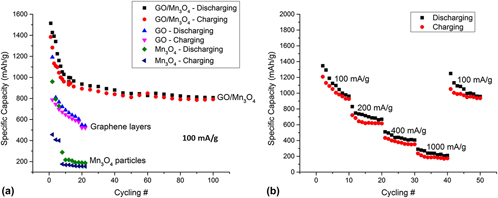Crossref Citations
This article has been cited by the following publications. This list is generated based on data provided by
Crossref.
Rahman, Md. Arafat
Wong, Yat Choy
Song, Guangsheng
and
Wen, Cuie
2015.
A review on porous negative electrodes for high performance lithium-ion batteries.
Journal of Porous Materials,
Vol. 22,
Issue. 5,
p.
1313.
Rahman, Md. Arafat
Song, Guangsheng
Bhatt, Anand I.
Wong, Yat Choy
and
Wen, Cuie
2016.
Nanostructured Silicon Anodes for High‐Performance Lithium‐Ion Batteries.
Advanced Functional Materials,
Vol. 26,
Issue. 5,
p.
647.
Tang, Justin
Liu, Wen
Wang, Hailiang
and
Gomez, Alessandro
2016.
High Performance Metal Oxide–Graphene Hybrid Nanomaterials Synthesized via Opposite‐Polarity Electrosprays.
Advanced Materials,
Vol. 28,
Issue. 46,
p.
10298.
Park, Seung-Keun
Seong, Chae-Yong
Yoo, Suyeon
and
Piao, Yuanzhe
2016.
Porous Mn3O4 nanorod/reduced graphene oxide hybrid paper as a flexible and binder-free anode material for lithium ion battery.
Energy,
Vol. 99,
Issue. ,
p.
266.
Zhang, Li-Hua
Wu, Si-Si
Wan, Yi
Huo, Yi-Feng
Luo, Yao-Cong
Yang, Ming-Yang
Li, Min-Chan
and
Lu, Zhou-Guang
2017.
Mn3O4/carbon nanotube nanocomposites recycled from waste alkaline Zn–MnO2 batteries as high-performance energy materials.
Rare Metals,
Vol. 36,
Issue. 5,
p.
442.
Liu, Binbin
Qi, Lei
Ye, Jiajia
Wang, Jieqiang
and
Xu, Caixia
2017.
Facile fabrication of graphene-encapsulated Mn3O4 octahedra cross-linked with a silver network as a high-capacity anode material for lithium ion batteries.
New Journal of Chemistry,
Vol. 41,
Issue. 22,
p.
13454.
Hao, Qin
Liu, Binbin
Ye, Jiajia
and
Xu, Caixia
2017.
Well encapsulated Mn3O4 octahedra in graphene nanosheets with much enhanced Li-storage performances.
Journal of Colloid and Interface Science,
Vol. 504,
Issue. ,
p.
603.
Palaniyandy, Nithyadharseni
Nkosi, Funeka P.
Raju, Kumar
and
Ozoemena, Kenneth I.
2018.
Fluorinated Mn3O4 nanospheres for lithium-ion batteries: Low-cost synthesis with enhanced capacity, cyclability and charge-transport.
Materials Chemistry and Physics,
Vol. 209,
Issue. ,
p.
65.
Tang, Xihao
Ma, Xiao
Qiu, Danfeng
Bu, Gang
Xia, Yongjun
Zhao, Bin
Lin, Zixia
and
Shi, Yi
2018.
Thermal Decomposition Synthesis of Graphene Nanosheets Anchored on Mn3O4 Nanoparticles as Anodes in Lithium Ion Batteries.
IOP Conference Series: Materials Science and Engineering,
Vol. 301,
Issue. ,
p.
012108.
Thesing, Anderson
Loguercio, Lara F.
Noremberg, Bruno S.
Alano, José H.
e Silva, Ricardo Marques
Orlandi, Marcelo O.
Marin, Graciane
Santos, Jacqueline F. Leite
and
Carreño, Neftali Lenin Villarreal
2019.
Tunable graphene oxide inter-sheet distance to obtain graphene oxide–silver nanoparticle hybrids.
New Journal of Chemistry,
Vol. 43,
Issue. 3,
p.
1285.
Zhang, Yanru
Wang, Zhengluo
Zaman, Fakhr uz
Zhao, Zhiwei
Sun, Xuan
Zhang, Jinyang
Hou, Linrui
and
Yuan, Changzhou
2019.
Hollow mesoporous hetero-ZnO/ZnMnO3 microspheres: template-free formation process and enhanced lithium storage capability towards Li-ion batteries as a competitive anode.
Journal of Materials Chemistry A,
Vol. 7,
Issue. 7,
p.
3264.
Zhang, Longhai
Zhang, Yanru
Xu, Senyang
Zhang, Chaofeng
Hou, Linrui
and
Yuan, Changzhou
2019.
Scalable Synthesis of One‐Dimensional Mesoporous ZnMnO3 Nanorods with Ultra‐Stable and High Rate Capability for Efficient Lithium Storage.
Chemistry – A European Journal,
Vol. 25,
Issue. 72,
p.
16683.
Sehrawat, Poonam
Abid, Abid
Islam, Saikh S.
Mauger, Alain
and
Julien, Christian M.
2020.
Nanostructured Graphene Oxide-Based Hybrids as Anodes for Lithium-Ion Batteries.
C,
Vol. 6,
Issue. 4,
p.
81.
Ko, Wen Yin
Sitindaon, Rina Se
Lubis, Andre Lammiduk
Yang, Yan Ru
Wang, Ho Ya
Lin, Shin Ting
and
Lin, Kuan Jiuh
2022.
Vertically-oriented zinc-doped γ-MnO2 nanowalls as high-rate anode materials for li-ion batteries.
Journal of Energy Storage,
Vol. 54,
Issue. ,
p.
105329.
Meng, Weili
Dong, Chao
Shao, Jing
Wang, Qingqing
Cheng, Hongwei
and
Gong, Hao
2022.
Reduced graphene oxide-Mn3O4 composites as effective electron acceptors for hybrid polymer-based solar cells.
Materials Science in Semiconductor Processing,
Vol. 145,
Issue. ,
p.
106638.
Sarpal, Sandeep
Singh, Avinash Kumar
Bhardwaj, Hema
Puri, Nitin Kumar
and
Solanki, Pratima R
2023.
Graphene oxide-Mn3O4 nanocomposites for advanced electrochemical biosensor for fumonisin B1 detection.
Nanotechnology,
Vol. 34,
Issue. 46,
p.
465708.



